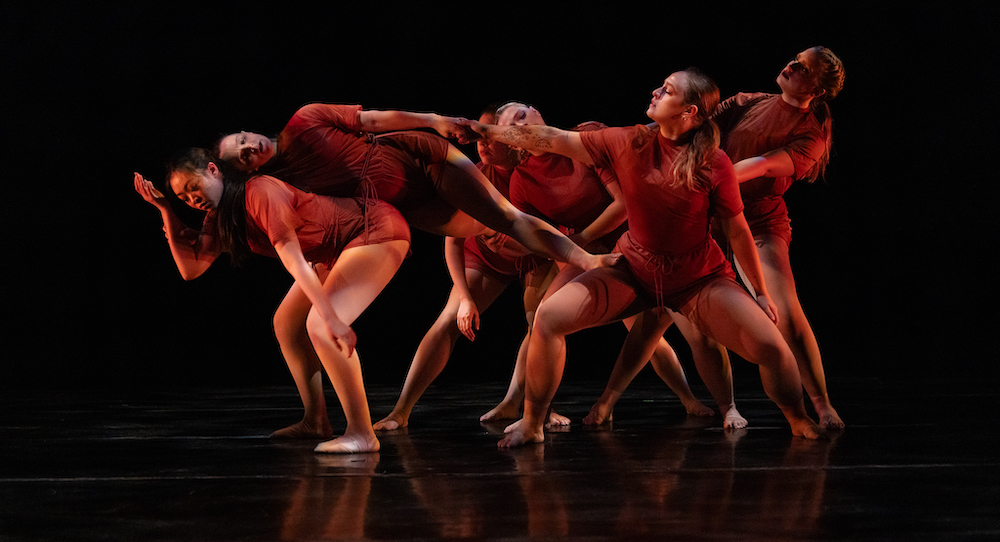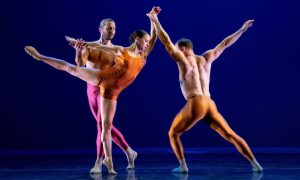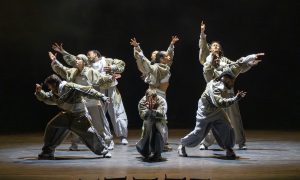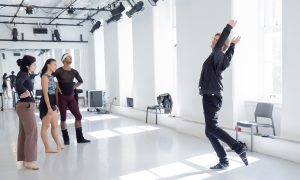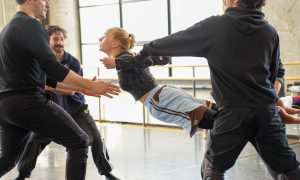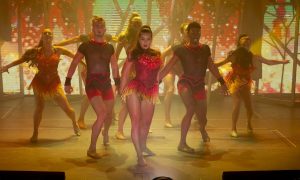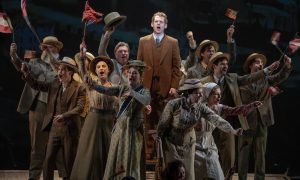Boston University Dance Theater, Boston, MA (viewed virtually).
June 22, 2024.
Often when I review dance, I perceive a theme that connects the various works within a certain program. I didn’t notice an apparent one in Greater Boston-based OnStage Dance Company’s Season 26 performance; it was more hodgepodge of various themes and styles. The advantage of that is a multifaceted picture of all that dance can be, can offer. This program presented that in spades, and quite commendably so – which is only OnStage’s par-for-the-course.
As perhaps my one critique – or curiosity – about the program, I wonder if more grouping like-with-like would have been more grounding and satisfying. Atmosphere and aesthetic sometimes changed drastically from piece to piece, which could feel just the slightest bit disorienting. A counter-argument there may be keeping things feeling as dynamic as the program overall was, and fair enough.
Far more memorably, this program gave me a sense of this company building a legacy, a tradition, a history – one grounded in its steadfast mission of extending performance opportunities to adults of various walks of life. “Throwback” works tipped a hat to previous seasons. Intermittent video montages gave windows into process, past and present.
Sometimes speaking over video of dancers working hard in rehearsal, choreographers discussed how they’ve grown in their craft through their years with OnStage, what concepts and stylistic approaches are currently inspiring them, and much more. All of that has come through just under 14 years (with two seasons per year, and accounting for COVID disruptions) of creating, performing, connecting as artists and as humans. All signs point to how that will continue for many years to come.
OnStage Director Jennifer Kuhnberg’s Mein Herr, a staple of the musical Cabaret, kicked off the show. It was ever so slightly quirky, with just a pinch of the enticingly sultry – a quality that’s very true to its musical of origin. Within the large ensemble, I could enjoy both unique dancer signatures and group cohesion (for example, a classic kickline). Both approaches helped create that quirky, sultry quality, and therein kept me fully engaged.
Erica Thorp’s “Throwback” You Should See Me in A Crown followed, with another vibrant ensemble. The score repeated messages that culture levies at women – which the dancers met with defiant ferocity. Black costumes, an electronica beat, and delightfully offbeat movement vocabulary (on top of a strong technical base) added to that mix a bold, edgy feel.
Moving into the more emotive contemporary, Emily Hong’s False Confidence brought me in through juxtapositional sharp gestures and expansive movements. The ensemble filled the stage with raw power and emotional commitment. Maddy Dugan’s Jungle – a jazz funk piece complete with high kicks, sparkly sequined shirts, and flashing lights – switched up the atmosphere yet again. Dancers hit unison counts as well as they made canons. Weaving in and out of each other’s paths, they felt connected. It reminded me that dance can be simply lively, and that’s valuable too.
With Mykayla Cohen’s What Was I Made For, set to Billie Eilish’s song of the same title, we were back to reflective contemporary. Cohen established a realistic atmosphere with school desks and costumes of slacks, blouses. Evocative moments of connection and disconnection created a sense of narrative at hand, but – as I think is something special about dance – that story could be many different things in the eye of the beholder.
Following that was a fun tap piece, of a red/black aesthetic as clean and cohesive as the tappers’ sounds: Victory Dance from Guest Choreographer Maya Jain, of Pistachio Groove (with Rehearsal Director Sara Lodgen). Claps added even more rhythm and spice – the party was on! The score bursted with vivacious Latin beats: points to Jain for exploring something relatively uncharted (at least not which I’ve experienced)!
Another “Throwback,” Catherine Shortliffe’s My Oh My, came next: a dance film bursting with authentic feeling, fresh movement vocabulary, and captivating cinematography. There was a slightly chilling mystery about these movers – even more so as they faded into clear, opacity increasing. It all came together into something ghostly, something to resonate into bone and stay there a while. On a movement level, the work illustrated how basic base movement vocabulary can be mixed and molded to support the atmosphere at hand.
Then came I Found from Victoria Rousseau: more heart-tugging contemporary, with dancers seeming to seek each other but remaining isolated. It was not overly athletic, but had reaching limbs and gestural intricacy to dazzle. Most striking was kinetic connection: with the power and grounding of the stage, with fluid connection of spine and periphery, in rhythm and in space.
In another notable shift of tone, a disco party took the stage with Allie Hahn’s The Place to Be. It was a true kaleidoscope of color and energy, bursting with infectious fun – the kind makes me wish I could be right up there on that stage with the performers! It didn’t take anything exceedingly virtuosic, as conventionally defined, to get there.
Back to emotive contemporary, Kuhnberg’s Black Flies offered a moment to breathe and feel a somber calm. Spirals contrasted linear movement, rises offset melts. As they assembled to lift one of their own higher, the ensemble embodied the score’s testament that “no man is an island.” They maintained connection of a different kind as they circled, executing unison movement. I wanted to sit in that healing connection for even longer.
Something more mysterious followed, Guest Choreographer Raffi Pontes’ Oya. The dancers’ navy blue unitards reflected the haunting chill in the singer’s voice (Ibeyi, with “Oya”). The dancers’ tenacity in movement only increased the edgy mystery filling the stage. Susan Oziemblewski’s Pay Your Way in Pain, following that, was offbeat and mysterious in a different way. Wigs of various colors, unconventional dresses, and choreography exuding pure self-confidence created a feeling of being “weird” and proud. I commend the boldness and authenticity brimming from this work!
That work began with a fantastic tap solo from Hannah Perry, and a full tap piece followed – Radio Remix from Perry herself. All we heard was pure tap beats, as there was no score (and it’s no easy task to stay on count without one). Dark slacks and sky blue blazers gave the feeling of assured business casual, of women lucid in their goals and ready to reach for them.
The final throwback in the program came next, Outta Your Mind from Naomi Owens and restaged by Hannah Perry. It opened with intriguing theatricality: of bored students sitting at their desks, peppering time with little moments of mischief. They doodled in notebooks and threw paper balls. The bell rang, and then they really let it loose.
Sharp, clean hip hop vocabulary translated their vim, verve, and “don’t mess” attitude. It was dance telling a story, but not a super deep or emotional one – and that’s alright. Life holds so many different experiences, ripe for the painting in and through bodies with this art form.
As is customary, a finale featuring the whole cast closed the program. Each dancer could have a moment in the spotlight – something special that this company always does, and which reflects their overall mission: giving hard-working adults of all different professions and places in life a chance to create, to express, to bring a little more light to this sometimes dark world. That can’t do everything, but it can still mean a lot. I look forward to seeing this company continue doing just that, and I thank them for it!
By Kathryn Boland of Dance Informa.


